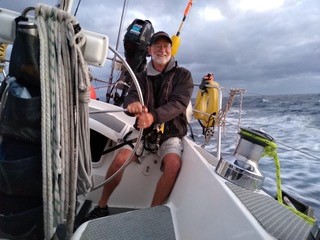
Hello everyone!
I’m back in Sacramento after my grand adventure which included 700+ nautical miles of open ocean sailing from NW Spain to Madeira.
Here’s one version of the tale, although my sailing buddies Mike Duda and Tom Flynn may remember things differently.
Tom, Mike, and I met up in the coastal port city of Vigo on Spain’s northwest coast. We had booked berths on the British adventure yacht Hummingbird run by Rubicon3: https://www.rubicon3.co.uk We read about these adventure sailing trips in Herb McCormick’s article in the May 2018 issue of Cruising World: https://www.cruisingworld.com/faroe-islands-sailing-adventure/ I wanted more open ocean time and, besides, the high latitudes were less interesting to me than discovering the wonders of Madeira, called “the pearl of the Atlantic.”
THE BOAT
Hummingbird is a Clipper 60, one of eight nearly identical boats built for the 1996 around the world race. She also competed in the 2000 and 2002 iterations of those races. https://en.wikipedia.org/wiki/Clipper_Round_the_World_Yacht_Race#Clipper_60 Originally called Blackadder (for you British comedy fans), the boat is 59’ 11” long, with a beam of 15’ 7” and draws 7’ 3” (draft). It’s a clipper rig which means that it carries two headsails (a Yankee and a staysail) in front of the mast. When these boats retired from racing, they were sold into private hands. Rubicon3 now owns three of the original Clipper 60s, plus one other boat.
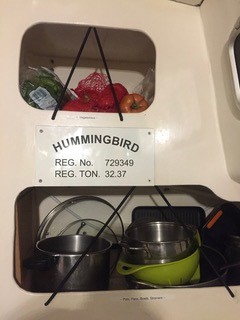
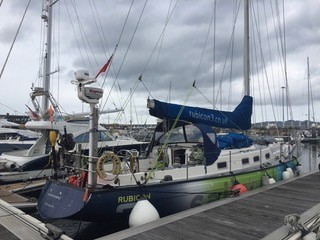
Hummingbird is a tremendously powerful and fast boat with bigger winches, more sail area, larger lines, and more gear than the 35’ – 45’ boats that I normally day-sail on San Francisco Bay or on charters. The result is that safety is genuinely important and Rubicon’s crew trained us well.
THE CREW
There were eight of us onboard for this adventure (October 29 to November 10). Four were British: 2 paid crew (Vince the skipper, Rick the mate) and 2 crew-in-training (Huw & Hannah want to become future mates and skippers for Rubicon). The other 4 paying crew were Americans, including the 3 of us from California and Ben, the East Coast guy. Many of you know that Mike Duda has been my best-guy-friend since we met during our first week at Saint Mary’s College in September 1967. We graduated from SMC in 1971, after spending of those years as roommates. We’ve sailed a lot together. Tom Flynn also lives here in east Sacramento and like us is also an SMC alumnus (Class of 1969).
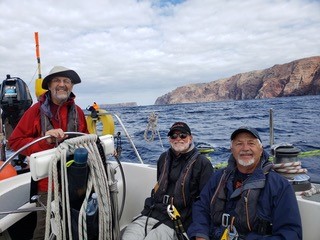
INTENTIONS NOT PLANS…
There’s an old saying that sailors don’t have plans, merely intentions. Weather, calendars, and unexpected events disrupt rigid plans, so you go with your intentions. Our adventure demonstrated that enduring truth. We went onboard about noon on Tuesday October 29, finding Hummingbird in a recreational marina in the port of Vigo. It was drizzling and we soon learned from the skipper and mate that a large weather system was roaring down out of the Atlantic, poised to smack western Europe. The original idea was to spend 3+ days training by day-sailing in Vigo bay so that we could learn the boat and get comfortable with each others’ skills. There’s plenty to learn on a big boat!
But we faced this choice. If we stayed several days to train, then we were likely to be pinned down for a week by the bad weather. But if we learned some basic safety lessons, we could leave in another day and sail fast down the Spanish and Portuguese coast, staying a day ahead of the advancing front. There would be several places that we could bail-out if needed (Porto, Lisbon, Lagos, or even Cadiz). We readily agreed that we’d come for an adventure sail, so let’s go.
BAIONA, THEN TO SEA!
On Wednesday October 30, we day-sailed down Vigo bay to a a marina at the small town of Baiona, near the bay entrance. Lots of learning along the way. Dinner onboard and the last hot showers for many days. Thursday October 31 we worked on more safety lessons, unpacking and restowing the drogue, practicing a Man Overboard (MOB) retrieval using a harness & halyard, and hoisting the bright orange storm sail. Unspoken was everyone’s hope that we’d never be in conditions where we needed to use those new skills .
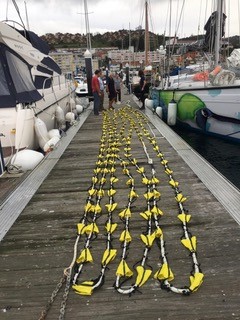
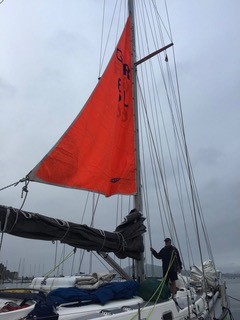
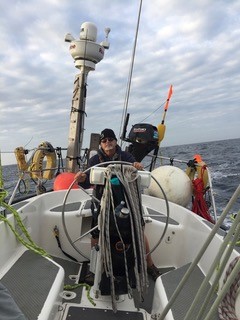
Then after lunch it was off the marina dock, heading out to sea in a drizzle adorned by a vibrant rainbow! Nice omen.
DOWN THE COAST.
Friday and for the next few days, Hummingbird ran south along the coast, <20 nautical miles off the mainland. The skipper’s strategy was to keep the boat moving fast, so sometimes we motorsailed. The combination of the powerful diesel and sails kept our boat speed above 7 knots (SOG) most of the time. The sail plan was usually the main with a single-reef, the #2 Yankee, and the staysail. In the hourly log, you’d write MR1, Y2, s/s for that sail plan. We weren’t more than 20 nm off the coast which we couldn’t see because of clouds, mist, and drizzle. Surprisingly, it wasn’t that cold, so wearing foul weather gear and gloves was more for avoiding the damp than staying warm.
Somehow my anti-seasickness patch fell off from behind my ear and I re-discovered just how miserable I can be. The mate sent me below to my bunk to sleep. Time to replace that Scopolamine patch, thanks Mike! By Saturday afternoon I was feeling semi-human again, able to help stand watch and help with chores (but not cooking the curry…). Hydration, small bland meals, and what the Brits called biscuits (yeah, they’re cookies) kept me going. On Saturday afternoon we’d reached the latitude of Cabo de Sao Vincente, where the Portuguese coast turns sharply eastward, running towards the Mediterranean. Decision time. The skipper convened the crew to discuss options and again unanimously we agreed to head for Madeira instead of heading into a harbor.
OPEN OCEAN.
After we changed course and started heading southwest out to sea, the weather went from drizzle to mostly cloudy to partly cloudy to gloriously blue. The Atlantic Ocean is really deep out there and the surface looked almost purple. A few shy dolphins briefly swam alongside, not in our bow wake, but dropped away after a short look at us. The wind increased to about 20 kt, the swells got taller and longer, and the boat settled into a lovely rhythm that used the swells instead of getting smacked as we had along the coast. Monday was superb sailing, one of the best days I’ve ever had on a boat. Because Hummingbird doesn’t have an autopilot or wind vane, it’s hand-steering all the way. In those conditions with well-balanced sails, however, steering was a joy, merely helping the boat sail fast and straight.
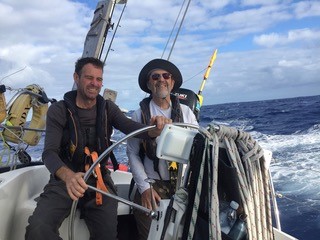
LAND HO!
Yeah, it’s a cliche, but when you see a smudge on the horizon after 4 days at sea, it’s an honest thrill. I happened to be on the helm Monday afternoon when someone caught sight of Isla Porto Santo, one of the small (but inhabited) islands of the Madeira group. It was our target and there it was. Land ho! The 2 crew-in-training had been navigating with sextants (but the sky was overcast), one true bearing on Berlenga Island days ago, and just old-fashioned dead reckoning. After days since their last reliable fix, they brought us within 10 nm of what the GPS downstairs was reporting. That’s fine work by Huw and Hannah!
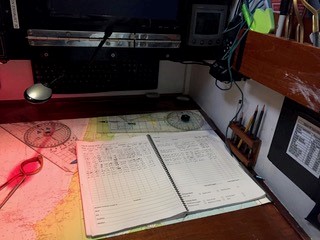
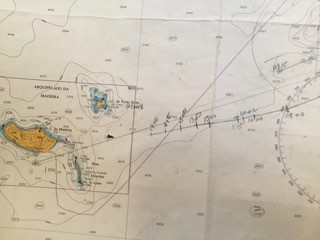
WE MADE IT.
By 8 pm Monday the skipper had safely anchored us in about 7 meters of water outside the breakwater of Porto Santo. Portuguese sailors had accidentally discovered this island in 1418, over 600 years before us! They were blown to the Madeira island group in a storm; we got there on purpose and took pictures of outside.
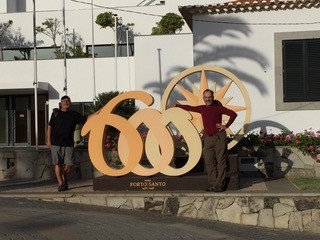
Hummingbird is (correctly) a “dry boat” underway for safety and reliability reasons. But now the hook was down and we celebrated our passage with beers all around. The next day ((Tuesday November 5) we moved the boat to the anchorage inside the breakwater and it was time for “shore leave.” Hot showers, walks into town, cold beers at the marina’s bar. Tuesday was also my 70th birthday which we celebrated with a hot breakfast and shots of smuggled bourbon. Thanks Mike! Many of the other transient boats were there on their way to the Canary Islands, to join this year’s version of the Atlantic Rally for Cruisers (ARC), the annual group pilgrimage from Europe-Africa to the Caribbean for the winter. Plenty of crews had painted their boats’ names and logos on the seawall.
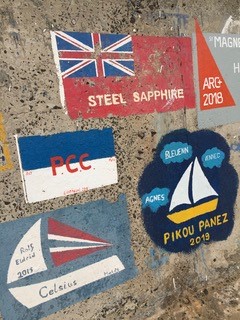
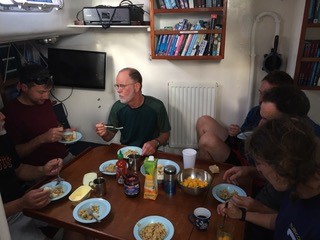
DAY SAILING MADEIRA.
Because we’d left Vigo-Baiona earlier than expected and because we made our 724 nm passage in just 4 1/2 days, we had time to sail around the Madeira islands for the next few days. The rugged cliffs of Baia d’Abra were stark and sheer. Only one other boat anchored there with us overnight. That part of eastern Madeira looks like the Baja California coast. The resort marina at Quinto do Lorde has a fancy hotel, shops, restaurants, showers, laundry, and a bar. If you’ve been to Ensenada’s Marina Coral, you’d recognize Quinto do Lorde. We enjoyed restaurant dinners, the chance to hang out with an espresso or cappuccino, and did I mention the hot showers? We didn’t take Hummingbird to the port of Funchal because there was no room in the marina for a 60’ boat, and anchoring was going to be rolly at best. The QdL marina was just fine as our temporary home base.
DESERTA GRANDE
Our skipper worked his magic, getting rare landing permits for us on Isla Deserta Grande, a nature reserve island about 14 nm from Madeira island. Knowing that it would be our last sailing day, I jumped at the chance to set up the headsails (Y2 & s/s), help hoist the mainsail, hoist the headsails, trim and re-trim, then reef the main. On a big boat, it’s a complicated set of procedures with little room for error. Clarity is as important as teamwork. On the boats that I normally sail, there’s room for making minor mistakes without getting hurt or hurting your crewmates. But handling sails on a big former racing boat requires close attention. And grinding. Then more grinding. And grinding some more. For a 70-year old guy who weights 140 pounds on a good day, that’s real work but what a pleasure to sail from Madeira to Deserta Grande. We were allowed to go ashore after anchoring (I managed to get a quick swim in the Atlantic). Exploring even a tiny part of the protected island with the Portuguese nature ranger was a hugely fascinating experience. Few sailors get permission to go onshore; almost none from California. Carlos the ranger was surprised. We were delighted.
We left the island’s precarious anchorage about 4 pm to sail back to our QdL marina berth. The winds dashed down the steep cliffs until we got clear of the island. And then I (selfishly) took the helm for at least 2 1/2 hours of our 4-hour trip back. While underway, Mike prepped for the risotto planned for dinner. I kept steering. Just after dusk the white light of the Madeira lighthouse winked at us, right where it was supposed to be. Reassuring as we pushed along at 8 kt in the dark. After putting us alongside the dock (“pontoon” to the Brits), Vince the skipper went below to make the risotto we enjoyed for dinner. Now that’s a guy who can do it all!
GOODBYE TO HUMMINGBIRD.
Sunday morning the 2 crew-in-training left at 5 am for the Funchal airport and their flight back to the UK. We finished packing our duffels, had our last breakfast, and stepped ashore at 9 am, leaving the crew to finish their chores before turning over the boat to the next Rubicon crew expected in a few days. We spent the night in Funchal (the much greener end of the island). Tom flew back to SFO on Monday morning. Mike and I stayed in Lisbon as tourists until Thursday when we took our own 13-hour flight nonstop back to SFO. I’ll spare you the backstory (bad pun…) about the intestinal bacteria that came home with me. Thank you Kaiser Permanente for the tests and antibiotics. I’m regaining weight.
We covered 815 nm from Vigo to Madeira, including that 724 nm passage. In terms of latitude, going from Baiona to Porto Santo is the equivalent of going from Brookings, Oregon (just north of the California state line) to Encinitas, California (just north of Del Mar in San Diego County). For you navigation geeks, that’s nine degrees of latitude (from 42 degrees, 7 minutes at Baiona to 33 degrees, 3 minutes at Porto Santo).
Rubicon’s motto is “SAIL. TRAIN. EXPLORE.” They delivered on every point. We were safe and returned with sailing skills that we’ll be using on SF Bay and coastal trips. Two thumbs up!
It was truly a grand adventure on a solid boat with fine crewmates. Grateful.
Peace and all good. – Peter

Great Accounting of the trip Peter !
Wow sailing 700+ nautical miles is amazing. Great job. I really enjoyed reading this so much. sailing from NW Spain to Madeira is amazing. Looking forward to reading more!